A Comprehensive Overview of Employment Law: Rights, Safety, and Cases
VerifiedAdded on 2023/06/14
|10
|2833
|153
Essay
AI Summary
This essay provides a comprehensive overview of employment law, focusing on the relationship between employers and employees. It discusses key aspects such as pay, leave, work time regulations, and health and safety laws, referencing relevant legislation like the Equality Act 2010, Employment Rights Act 1996, and Health and Safety at Work etc. Act 1974. The essay examines landmark cases like Lawrence v Regent Office Care Ltd and Wilson v United Kingdom to illustrate the application of these laws. Furthermore, it delves into the concepts of wrongful and unfair dismissal under the Employment Relations Act 1996, highlighting the rights of employees and the responsibilities of employers. The essay emphasizes the importance of mutual trust and respect in the workplace and concludes by underscoring the significance of fair processes in dismissal cases.

Running head: EMPLOYMENT LAW
Employment law
Name of the Student
Name of the University
Author Note
Employment law
Name of the Student
Name of the University
Author Note
Paraphrase This Document
Need a fresh take? Get an instant paraphrase of this document with our AI Paraphraser

1EMPLOYMENT LAW
Introduction
Employment law also is known as labor law, which helps to maintain the relationship
between an employee and an employer. There are several laws and regulations made to enhance
the relationship of the employee with their employers and unions. In case these laws are not
followed then illegal liabilities may occur. The enforcement of these laws are done by the
government agencies and they are legislative executive and judiciary. There are laws for child
labor, the working time of labor, dismissal of an employee, health and safety of an employee
whether it be a man or a woman (The City Law School 2016).
Body
1.
Pay- The minimum wage or the pay an employee must get totally depends on the type of
their work and age. The National Minimum Wage is the pay that every worker gets on hourly
basis. It is said that national minimum wage is less than national living wage and those workers
get it who are over the age of twenty-five. The owner must pay the employee correct wage and
must not depend on how small the work of an employee is. The worker must check their wage.
According to section 78 of The Equality Act 2010 every employee whether male or female has
the right to equal pay which means every single employee must receive equal pay for their work
and to increase the accountability of the business. It is the duty of the employer to check whether
the employees are getting proper minimum wage and they must repay the wage from their earlier
jobs. The employees must have information about gender pay gap. The regulations under the
Equality Act 2010 describes the information regarding employees, information regarding
employers, ways of calculating the number of employees, time of publishing the information. If
Introduction
Employment law also is known as labor law, which helps to maintain the relationship
between an employee and an employer. There are several laws and regulations made to enhance
the relationship of the employee with their employers and unions. In case these laws are not
followed then illegal liabilities may occur. The enforcement of these laws are done by the
government agencies and they are legislative executive and judiciary. There are laws for child
labor, the working time of labor, dismissal of an employee, health and safety of an employee
whether it be a man or a woman (The City Law School 2016).
Body
1.
Pay- The minimum wage or the pay an employee must get totally depends on the type of
their work and age. The National Minimum Wage is the pay that every worker gets on hourly
basis. It is said that national minimum wage is less than national living wage and those workers
get it who are over the age of twenty-five. The owner must pay the employee correct wage and
must not depend on how small the work of an employee is. The worker must check their wage.
According to section 78 of The Equality Act 2010 every employee whether male or female has
the right to equal pay which means every single employee must receive equal pay for their work
and to increase the accountability of the business. It is the duty of the employer to check whether
the employees are getting proper minimum wage and they must repay the wage from their earlier
jobs. The employees must have information about gender pay gap. The regulations under the
Equality Act 2010 describes the information regarding employees, information regarding
employers, ways of calculating the number of employees, time of publishing the information. If
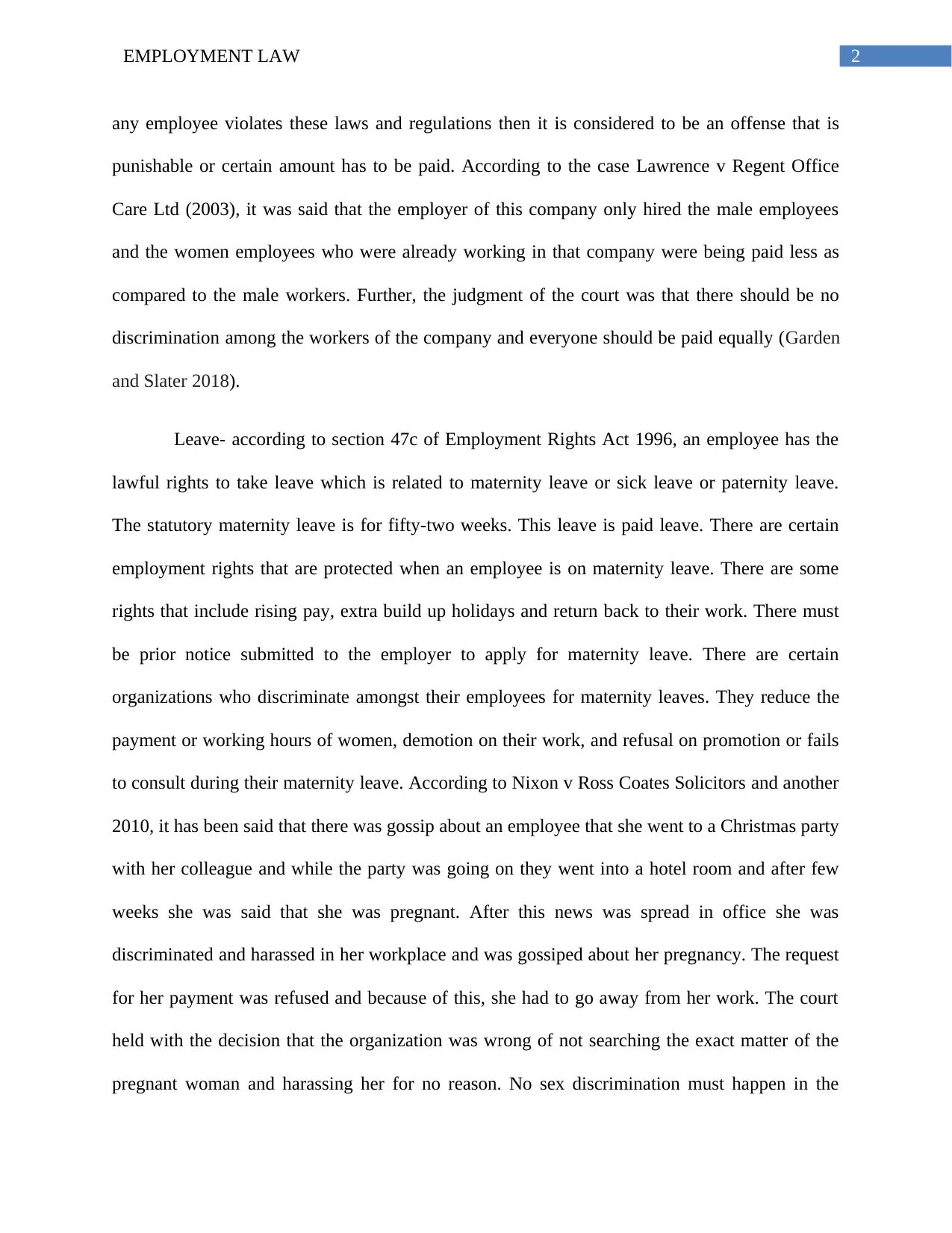
2EMPLOYMENT LAW
any employee violates these laws and regulations then it is considered to be an offense that is
punishable or certain amount has to be paid. According to the case Lawrence v Regent Office
Care Ltd (2003), it was said that the employer of this company only hired the male employees
and the women employees who were already working in that company were being paid less as
compared to the male workers. Further, the judgment of the court was that there should be no
discrimination among the workers of the company and everyone should be paid equally (Garden
and Slater 2018).
Leave- according to section 47c of Employment Rights Act 1996, an employee has the
lawful rights to take leave which is related to maternity leave or sick leave or paternity leave.
The statutory maternity leave is for fifty-two weeks. This leave is paid leave. There are certain
employment rights that are protected when an employee is on maternity leave. There are some
rights that include rising pay, extra build up holidays and return back to their work. There must
be prior notice submitted to the employer to apply for maternity leave. There are certain
organizations who discriminate amongst their employees for maternity leaves. They reduce the
payment or working hours of women, demotion on their work, and refusal on promotion or fails
to consult during their maternity leave. According to Nixon v Ross Coates Solicitors and another
2010, it has been said that there was gossip about an employee that she went to a Christmas party
with her colleague and while the party was going on they went into a hotel room and after few
weeks she was said that she was pregnant. After this news was spread in office she was
discriminated and harassed in her workplace and was gossiped about her pregnancy. The request
for her payment was refused and because of this, she had to go away from her work. The court
held with the decision that the organization was wrong of not searching the exact matter of the
pregnant woman and harassing her for no reason. No sex discrimination must happen in the
any employee violates these laws and regulations then it is considered to be an offense that is
punishable or certain amount has to be paid. According to the case Lawrence v Regent Office
Care Ltd (2003), it was said that the employer of this company only hired the male employees
and the women employees who were already working in that company were being paid less as
compared to the male workers. Further, the judgment of the court was that there should be no
discrimination among the workers of the company and everyone should be paid equally (Garden
and Slater 2018).
Leave- according to section 47c of Employment Rights Act 1996, an employee has the
lawful rights to take leave which is related to maternity leave or sick leave or paternity leave.
The statutory maternity leave is for fifty-two weeks. This leave is paid leave. There are certain
employment rights that are protected when an employee is on maternity leave. There are some
rights that include rising pay, extra build up holidays and return back to their work. There must
be prior notice submitted to the employer to apply for maternity leave. There are certain
organizations who discriminate amongst their employees for maternity leaves. They reduce the
payment or working hours of women, demotion on their work, and refusal on promotion or fails
to consult during their maternity leave. According to Nixon v Ross Coates Solicitors and another
2010, it has been said that there was gossip about an employee that she went to a Christmas party
with her colleague and while the party was going on they went into a hotel room and after few
weeks she was said that she was pregnant. After this news was spread in office she was
discriminated and harassed in her workplace and was gossiped about her pregnancy. The request
for her payment was refused and because of this, she had to go away from her work. The court
held with the decision that the organization was wrong of not searching the exact matter of the
pregnant woman and harassing her for no reason. No sex discrimination must happen in the
⊘ This is a preview!⊘
Do you want full access?
Subscribe today to unlock all pages.

Trusted by 1+ million students worldwide
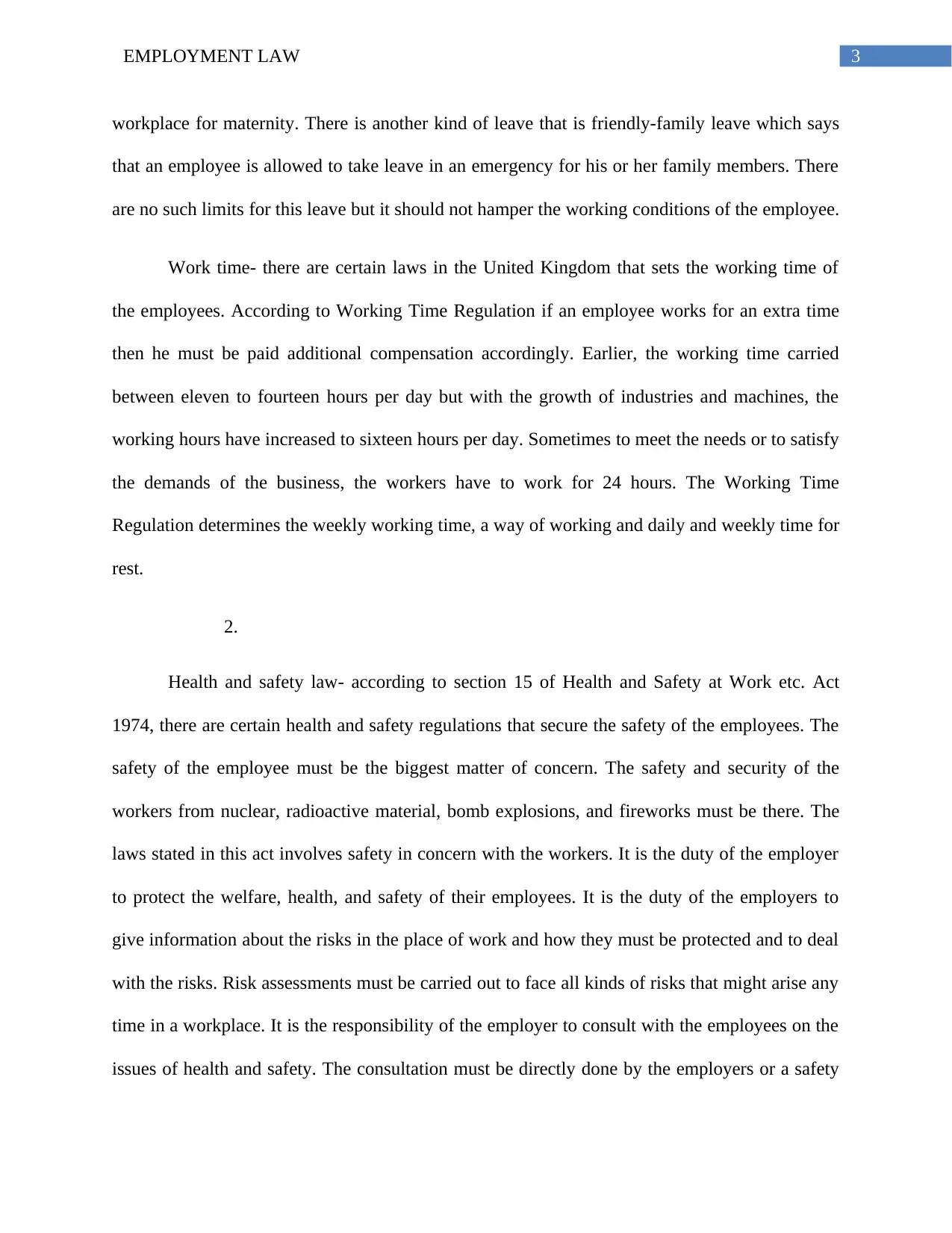
3EMPLOYMENT LAW
workplace for maternity. There is another kind of leave that is friendly-family leave which says
that an employee is allowed to take leave in an emergency for his or her family members. There
are no such limits for this leave but it should not hamper the working conditions of the employee.
Work time- there are certain laws in the United Kingdom that sets the working time of
the employees. According to Working Time Regulation if an employee works for an extra time
then he must be paid additional compensation accordingly. Earlier, the working time carried
between eleven to fourteen hours per day but with the growth of industries and machines, the
working hours have increased to sixteen hours per day. Sometimes to meet the needs or to satisfy
the demands of the business, the workers have to work for 24 hours. The Working Time
Regulation determines the weekly working time, a way of working and daily and weekly time for
rest.
2.
Health and safety law- according to section 15 of Health and Safety at Work etc. Act
1974, there are certain health and safety regulations that secure the safety of the employees. The
safety of the employee must be the biggest matter of concern. The safety and security of the
workers from nuclear, radioactive material, bomb explosions, and fireworks must be there. The
laws stated in this act involves safety in concern with the workers. It is the duty of the employer
to protect the welfare, health, and safety of their employees. It is the duty of the employers to
give information about the risks in the place of work and how they must be protected and to deal
with the risks. Risk assessments must be carried out to face all kinds of risks that might arise any
time in a workplace. It is the responsibility of the employer to consult with the employees on the
issues of health and safety. The consultation must be directly done by the employers or a safety
workplace for maternity. There is another kind of leave that is friendly-family leave which says
that an employee is allowed to take leave in an emergency for his or her family members. There
are no such limits for this leave but it should not hamper the working conditions of the employee.
Work time- there are certain laws in the United Kingdom that sets the working time of
the employees. According to Working Time Regulation if an employee works for an extra time
then he must be paid additional compensation accordingly. Earlier, the working time carried
between eleven to fourteen hours per day but with the growth of industries and machines, the
working hours have increased to sixteen hours per day. Sometimes to meet the needs or to satisfy
the demands of the business, the workers have to work for 24 hours. The Working Time
Regulation determines the weekly working time, a way of working and daily and weekly time for
rest.
2.
Health and safety law- according to section 15 of Health and Safety at Work etc. Act
1974, there are certain health and safety regulations that secure the safety of the employees. The
safety of the employee must be the biggest matter of concern. The safety and security of the
workers from nuclear, radioactive material, bomb explosions, and fireworks must be there. The
laws stated in this act involves safety in concern with the workers. It is the duty of the employer
to protect the welfare, health, and safety of their employees. It is the duty of the employers to
give information about the risks in the place of work and how they must be protected and to deal
with the risks. Risk assessments must be carried out to face all kinds of risks that might arise any
time in a workplace. It is the responsibility of the employer to consult with the employees on the
issues of health and safety. The consultation must be directly done by the employers or a safety
Paraphrase This Document
Need a fresh take? Get an instant paraphrase of this document with our AI Paraphraser
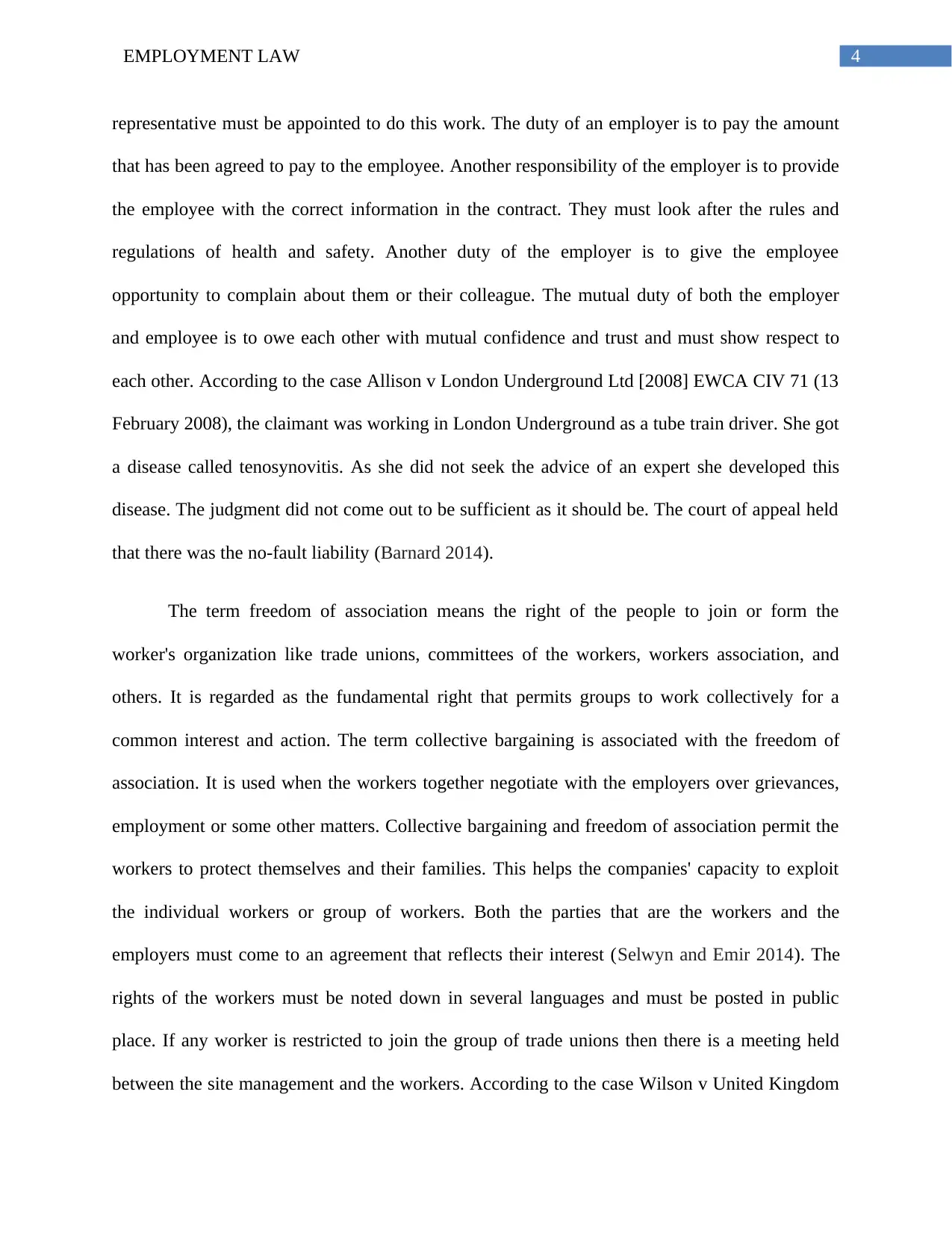
4EMPLOYMENT LAW
representative must be appointed to do this work. The duty of an employer is to pay the amount
that has been agreed to pay to the employee. Another responsibility of the employer is to provide
the employee with the correct information in the contract. They must look after the rules and
regulations of health and safety. Another duty of the employer is to give the employee
opportunity to complain about them or their colleague. The mutual duty of both the employer
and employee is to owe each other with mutual confidence and trust and must show respect to
each other. According to the case Allison v London Underground Ltd [2008] EWCA CIV 71 (13
February 2008), the claimant was working in London Underground as a tube train driver. She got
a disease called tenosynovitis. As she did not seek the advice of an expert she developed this
disease. The judgment did not come out to be sufficient as it should be. The court of appeal held
that there was the no-fault liability (Barnard 2014).
The term freedom of association means the right of the people to join or form the
worker's organization like trade unions, committees of the workers, workers association, and
others. It is regarded as the fundamental right that permits groups to work collectively for a
common interest and action. The term collective bargaining is associated with the freedom of
association. It is used when the workers together negotiate with the employers over grievances,
employment or some other matters. Collective bargaining and freedom of association permit the
workers to protect themselves and their families. This helps the companies' capacity to exploit
the individual workers or group of workers. Both the parties that are the workers and the
employers must come to an agreement that reflects their interest (Selwyn and Emir 2014). The
rights of the workers must be noted down in several languages and must be posted in public
place. If any worker is restricted to join the group of trade unions then there is a meeting held
between the site management and the workers. According to the case Wilson v United Kingdom
representative must be appointed to do this work. The duty of an employer is to pay the amount
that has been agreed to pay to the employee. Another responsibility of the employer is to provide
the employee with the correct information in the contract. They must look after the rules and
regulations of health and safety. Another duty of the employer is to give the employee
opportunity to complain about them or their colleague. The mutual duty of both the employer
and employee is to owe each other with mutual confidence and trust and must show respect to
each other. According to the case Allison v London Underground Ltd [2008] EWCA CIV 71 (13
February 2008), the claimant was working in London Underground as a tube train driver. She got
a disease called tenosynovitis. As she did not seek the advice of an expert she developed this
disease. The judgment did not come out to be sufficient as it should be. The court of appeal held
that there was the no-fault liability (Barnard 2014).
The term freedom of association means the right of the people to join or form the
worker's organization like trade unions, committees of the workers, workers association, and
others. It is regarded as the fundamental right that permits groups to work collectively for a
common interest and action. The term collective bargaining is associated with the freedom of
association. It is used when the workers together negotiate with the employers over grievances,
employment or some other matters. Collective bargaining and freedom of association permit the
workers to protect themselves and their families. This helps the companies' capacity to exploit
the individual workers or group of workers. Both the parties that are the workers and the
employers must come to an agreement that reflects their interest (Selwyn and Emir 2014). The
rights of the workers must be noted down in several languages and must be posted in public
place. If any worker is restricted to join the group of trade unions then there is a meeting held
between the site management and the workers. According to the case Wilson v United Kingdom
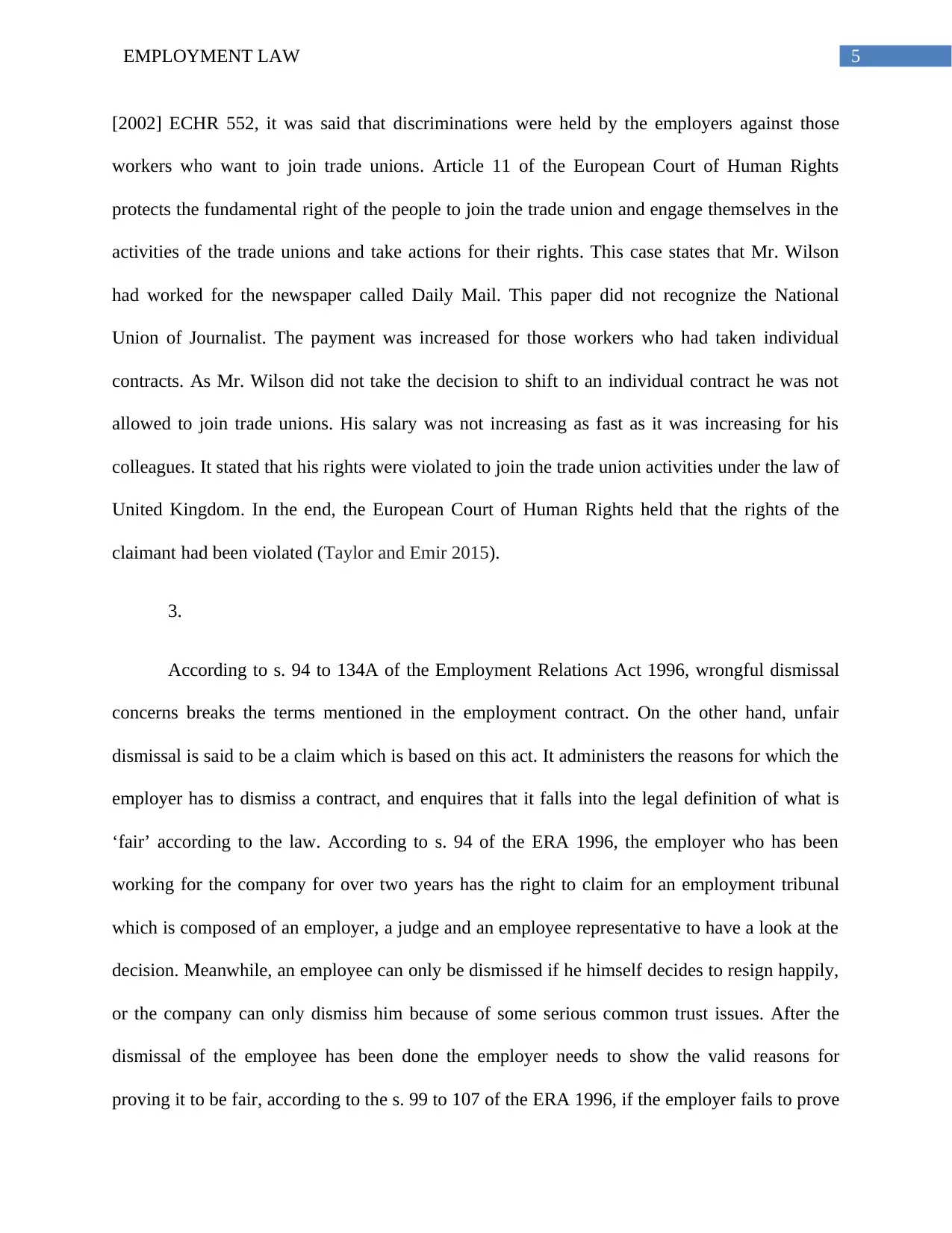
5EMPLOYMENT LAW
[2002] ECHR 552, it was said that discriminations were held by the employers against those
workers who want to join trade unions. Article 11 of the European Court of Human Rights
protects the fundamental right of the people to join the trade union and engage themselves in the
activities of the trade unions and take actions for their rights. This case states that Mr. Wilson
had worked for the newspaper called Daily Mail. This paper did not recognize the National
Union of Journalist. The payment was increased for those workers who had taken individual
contracts. As Mr. Wilson did not take the decision to shift to an individual contract he was not
allowed to join trade unions. His salary was not increasing as fast as it was increasing for his
colleagues. It stated that his rights were violated to join the trade union activities under the law of
United Kingdom. In the end, the European Court of Human Rights held that the rights of the
claimant had been violated (Taylor and Emir 2015).
3.
According to s. 94 to 134A of the Employment Relations Act 1996, wrongful dismissal
concerns breaks the terms mentioned in the employment contract. On the other hand, unfair
dismissal is said to be a claim which is based on this act. It administers the reasons for which the
employer has to dismiss a contract, and enquires that it falls into the legal definition of what is
‘fair’ according to the law. According to s. 94 of the ERA 1996, the employer who has been
working for the company for over two years has the right to claim for an employment tribunal
which is composed of an employer, a judge and an employee representative to have a look at the
decision. Meanwhile, an employee can only be dismissed if he himself decides to resign happily,
or the company can only dismiss him because of some serious common trust issues. After the
dismissal of the employee has been done the employer needs to show the valid reasons for
proving it to be fair, according to the s. 99 to 107 of the ERA 1996, if the employer fails to prove
[2002] ECHR 552, it was said that discriminations were held by the employers against those
workers who want to join trade unions. Article 11 of the European Court of Human Rights
protects the fundamental right of the people to join the trade union and engage themselves in the
activities of the trade unions and take actions for their rights. This case states that Mr. Wilson
had worked for the newspaper called Daily Mail. This paper did not recognize the National
Union of Journalist. The payment was increased for those workers who had taken individual
contracts. As Mr. Wilson did not take the decision to shift to an individual contract he was not
allowed to join trade unions. His salary was not increasing as fast as it was increasing for his
colleagues. It stated that his rights were violated to join the trade union activities under the law of
United Kingdom. In the end, the European Court of Human Rights held that the rights of the
claimant had been violated (Taylor and Emir 2015).
3.
According to s. 94 to 134A of the Employment Relations Act 1996, wrongful dismissal
concerns breaks the terms mentioned in the employment contract. On the other hand, unfair
dismissal is said to be a claim which is based on this act. It administers the reasons for which the
employer has to dismiss a contract, and enquires that it falls into the legal definition of what is
‘fair’ according to the law. According to s. 94 of the ERA 1996, the employer who has been
working for the company for over two years has the right to claim for an employment tribunal
which is composed of an employer, a judge and an employee representative to have a look at the
decision. Meanwhile, an employee can only be dismissed if he himself decides to resign happily,
or the company can only dismiss him because of some serious common trust issues. After the
dismissal of the employee has been done the employer needs to show the valid reasons for
proving it to be fair, according to the s. 99 to 107 of the ERA 1996, if the employer fails to prove
⊘ This is a preview!⊘
Do you want full access?
Subscribe today to unlock all pages.

Trusted by 1+ million students worldwide
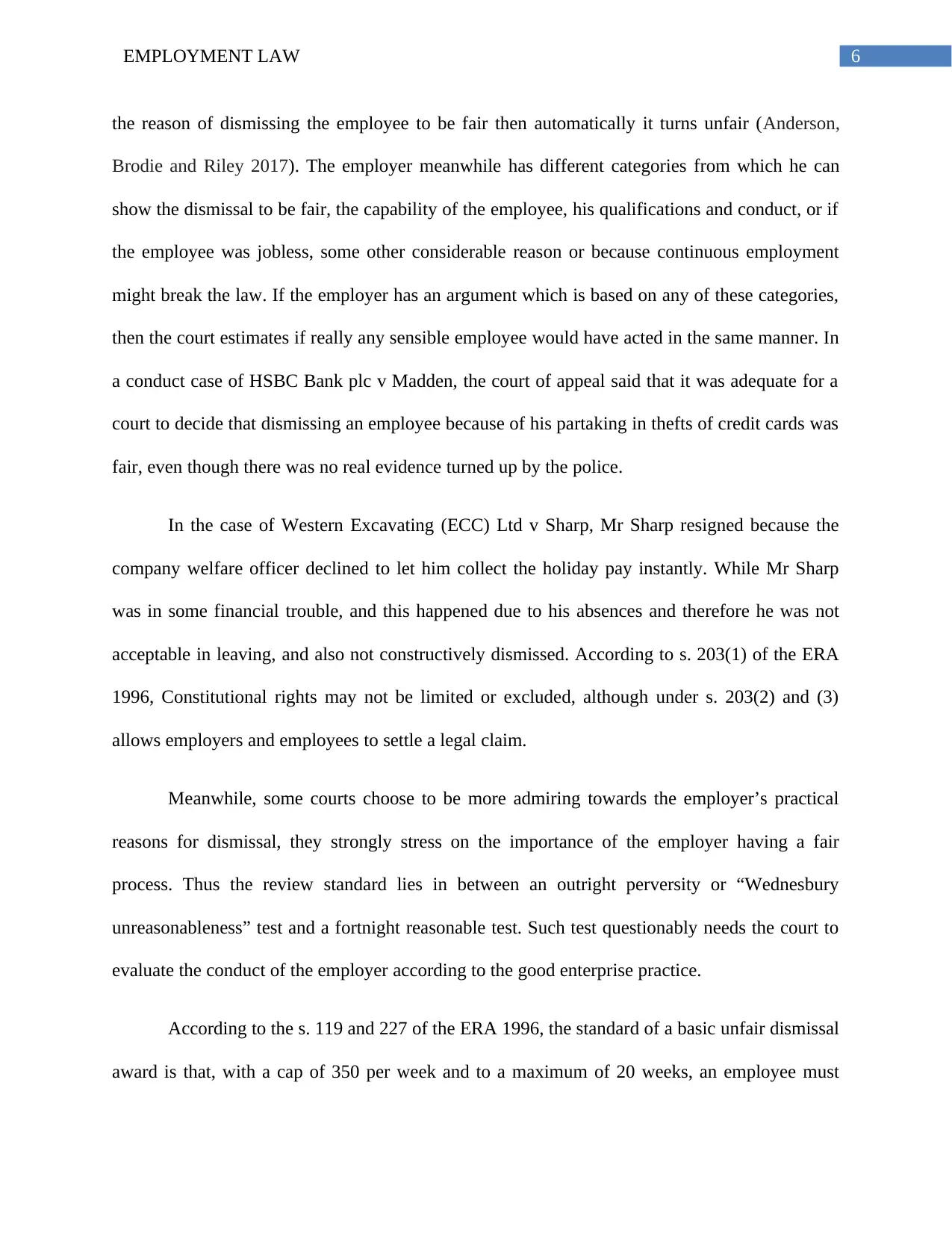
6EMPLOYMENT LAW
the reason of dismissing the employee to be fair then automatically it turns unfair (Anderson,
Brodie and Riley 2017). The employer meanwhile has different categories from which he can
show the dismissal to be fair, the capability of the employee, his qualifications and conduct, or if
the employee was jobless, some other considerable reason or because continuous employment
might break the law. If the employer has an argument which is based on any of these categories,
then the court estimates if really any sensible employee would have acted in the same manner. In
a conduct case of HSBC Bank plc v Madden, the court of appeal said that it was adequate for a
court to decide that dismissing an employee because of his partaking in thefts of credit cards was
fair, even though there was no real evidence turned up by the police.
In the case of Western Excavating (ECC) Ltd v Sharp, Mr Sharp resigned because the
company welfare officer declined to let him collect the holiday pay instantly. While Mr Sharp
was in some financial trouble, and this happened due to his absences and therefore he was not
acceptable in leaving, and also not constructively dismissed. According to s. 203(1) of the ERA
1996, Constitutional rights may not be limited or excluded, although under s. 203(2) and (3)
allows employers and employees to settle a legal claim.
Meanwhile, some courts choose to be more admiring towards the employer’s practical
reasons for dismissal, they strongly stress on the importance of the employer having a fair
process. Thus the review standard lies in between an outright perversity or “Wednesbury
unreasonableness” test and a fortnight reasonable test. Such test questionably needs the court to
evaluate the conduct of the employer according to the good enterprise practice.
According to the s. 119 and 227 of the ERA 1996, the standard of a basic unfair dismissal
award is that, with a cap of 350 per week and to a maximum of 20 weeks, an employee must
the reason of dismissing the employee to be fair then automatically it turns unfair (Anderson,
Brodie and Riley 2017). The employer meanwhile has different categories from which he can
show the dismissal to be fair, the capability of the employee, his qualifications and conduct, or if
the employee was jobless, some other considerable reason or because continuous employment
might break the law. If the employer has an argument which is based on any of these categories,
then the court estimates if really any sensible employee would have acted in the same manner. In
a conduct case of HSBC Bank plc v Madden, the court of appeal said that it was adequate for a
court to decide that dismissing an employee because of his partaking in thefts of credit cards was
fair, even though there was no real evidence turned up by the police.
In the case of Western Excavating (ECC) Ltd v Sharp, Mr Sharp resigned because the
company welfare officer declined to let him collect the holiday pay instantly. While Mr Sharp
was in some financial trouble, and this happened due to his absences and therefore he was not
acceptable in leaving, and also not constructively dismissed. According to s. 203(1) of the ERA
1996, Constitutional rights may not be limited or excluded, although under s. 203(2) and (3)
allows employers and employees to settle a legal claim.
Meanwhile, some courts choose to be more admiring towards the employer’s practical
reasons for dismissal, they strongly stress on the importance of the employer having a fair
process. Thus the review standard lies in between an outright perversity or “Wednesbury
unreasonableness” test and a fortnight reasonable test. Such test questionably needs the court to
evaluate the conduct of the employer according to the good enterprise practice.
According to the s. 119 and 227 of the ERA 1996, the standard of a basic unfair dismissal
award is that, with a cap of 350 per week and to a maximum of 20 weeks, an employee must
Paraphrase This Document
Need a fresh take? Get an instant paraphrase of this document with our AI Paraphraser
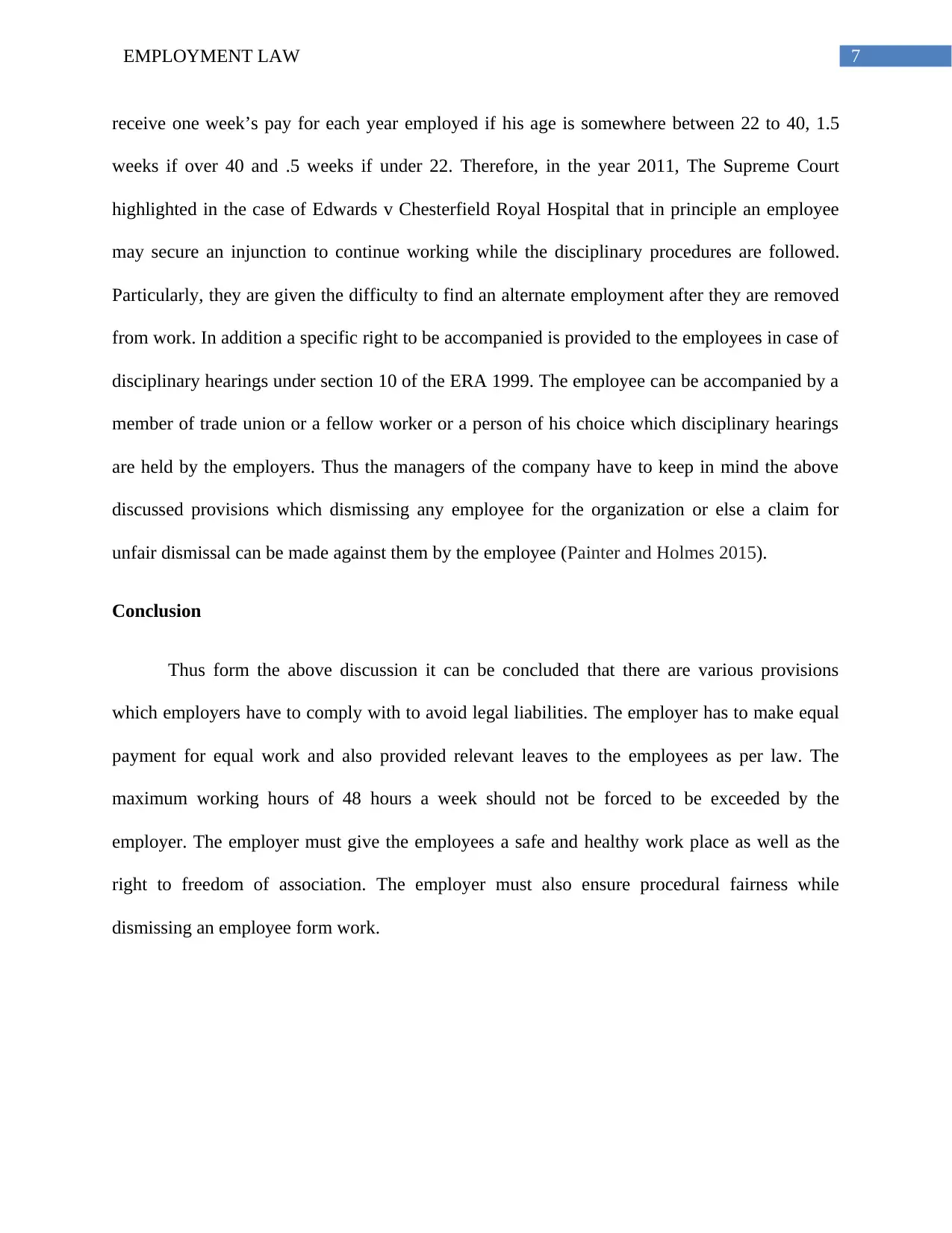
7EMPLOYMENT LAW
receive one week’s pay for each year employed if his age is somewhere between 22 to 40, 1.5
weeks if over 40 and .5 weeks if under 22. Therefore, in the year 2011, The Supreme Court
highlighted in the case of Edwards v Chesterfield Royal Hospital that in principle an employee
may secure an injunction to continue working while the disciplinary procedures are followed.
Particularly, they are given the difficulty to find an alternate employment after they are removed
from work. In addition a specific right to be accompanied is provided to the employees in case of
disciplinary hearings under section 10 of the ERA 1999. The employee can be accompanied by a
member of trade union or a fellow worker or a person of his choice which disciplinary hearings
are held by the employers. Thus the managers of the company have to keep in mind the above
discussed provisions which dismissing any employee for the organization or else a claim for
unfair dismissal can be made against them by the employee (Painter and Holmes 2015).
Conclusion
Thus form the above discussion it can be concluded that there are various provisions
which employers have to comply with to avoid legal liabilities. The employer has to make equal
payment for equal work and also provided relevant leaves to the employees as per law. The
maximum working hours of 48 hours a week should not be forced to be exceeded by the
employer. The employer must give the employees a safe and healthy work place as well as the
right to freedom of association. The employer must also ensure procedural fairness while
dismissing an employee form work.
receive one week’s pay for each year employed if his age is somewhere between 22 to 40, 1.5
weeks if over 40 and .5 weeks if under 22. Therefore, in the year 2011, The Supreme Court
highlighted in the case of Edwards v Chesterfield Royal Hospital that in principle an employee
may secure an injunction to continue working while the disciplinary procedures are followed.
Particularly, they are given the difficulty to find an alternate employment after they are removed
from work. In addition a specific right to be accompanied is provided to the employees in case of
disciplinary hearings under section 10 of the ERA 1999. The employee can be accompanied by a
member of trade union or a fellow worker or a person of his choice which disciplinary hearings
are held by the employers. Thus the managers of the company have to keep in mind the above
discussed provisions which dismissing any employee for the organization or else a claim for
unfair dismissal can be made against them by the employee (Painter and Holmes 2015).
Conclusion
Thus form the above discussion it can be concluded that there are various provisions
which employers have to comply with to avoid legal liabilities. The employer has to make equal
payment for equal work and also provided relevant leaves to the employees as per law. The
maximum working hours of 48 hours a week should not be forced to be exceeded by the
employer. The employer must give the employees a safe and healthy work place as well as the
right to freedom of association. The employer must also ensure procedural fairness while
dismissing an employee form work.
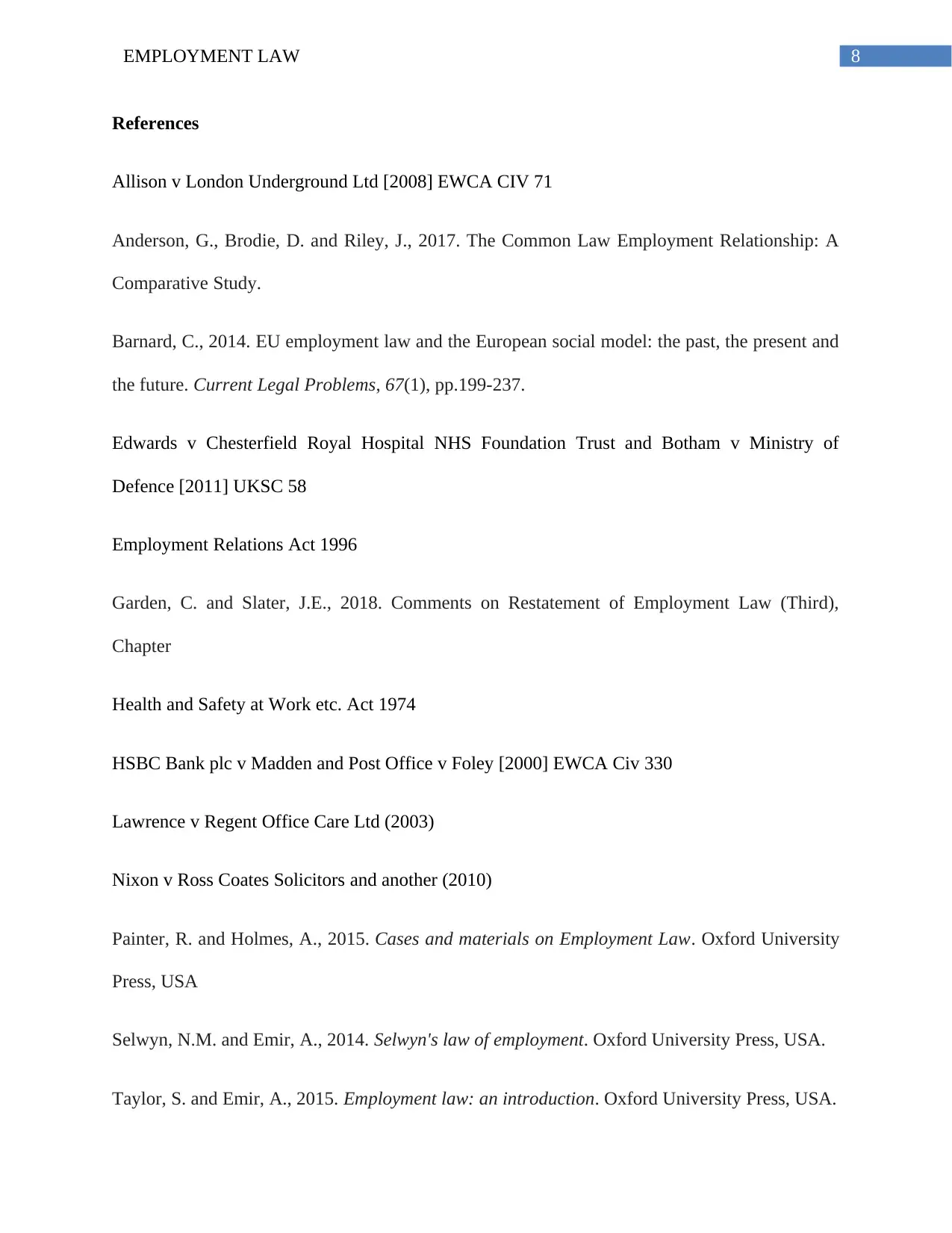
8EMPLOYMENT LAW
References
Allison v London Underground Ltd [2008] EWCA CIV 71
Anderson, G., Brodie, D. and Riley, J., 2017. The Common Law Employment Relationship: A
Comparative Study.
Barnard, C., 2014. EU employment law and the European social model: the past, the present and
the future. Current Legal Problems, 67(1), pp.199-237.
Edwards v Chesterfield Royal Hospital NHS Foundation Trust and Botham v Ministry of
Defence [2011] UKSC 58
Employment Relations Act 1996
Garden, C. and Slater, J.E., 2018. Comments on Restatement of Employment Law (Third),
Chapter
Health and Safety at Work etc. Act 1974
HSBC Bank plc v Madden and Post Office v Foley [2000] EWCA Civ 330
Lawrence v Regent Office Care Ltd (2003)
Nixon v Ross Coates Solicitors and another (2010)
Painter, R. and Holmes, A., 2015. Cases and materials on Employment Law. Oxford University
Press, USA
Selwyn, N.M. and Emir, A., 2014. Selwyn's law of employment. Oxford University Press, USA.
Taylor, S. and Emir, A., 2015. Employment law: an introduction. Oxford University Press, USA.
References
Allison v London Underground Ltd [2008] EWCA CIV 71
Anderson, G., Brodie, D. and Riley, J., 2017. The Common Law Employment Relationship: A
Comparative Study.
Barnard, C., 2014. EU employment law and the European social model: the past, the present and
the future. Current Legal Problems, 67(1), pp.199-237.
Edwards v Chesterfield Royal Hospital NHS Foundation Trust and Botham v Ministry of
Defence [2011] UKSC 58
Employment Relations Act 1996
Garden, C. and Slater, J.E., 2018. Comments on Restatement of Employment Law (Third),
Chapter
Health and Safety at Work etc. Act 1974
HSBC Bank plc v Madden and Post Office v Foley [2000] EWCA Civ 330
Lawrence v Regent Office Care Ltd (2003)
Nixon v Ross Coates Solicitors and another (2010)
Painter, R. and Holmes, A., 2015. Cases and materials on Employment Law. Oxford University
Press, USA
Selwyn, N.M. and Emir, A., 2014. Selwyn's law of employment. Oxford University Press, USA.
Taylor, S. and Emir, A., 2015. Employment law: an introduction. Oxford University Press, USA.
⊘ This is a preview!⊘
Do you want full access?
Subscribe today to unlock all pages.

Trusted by 1+ million students worldwide
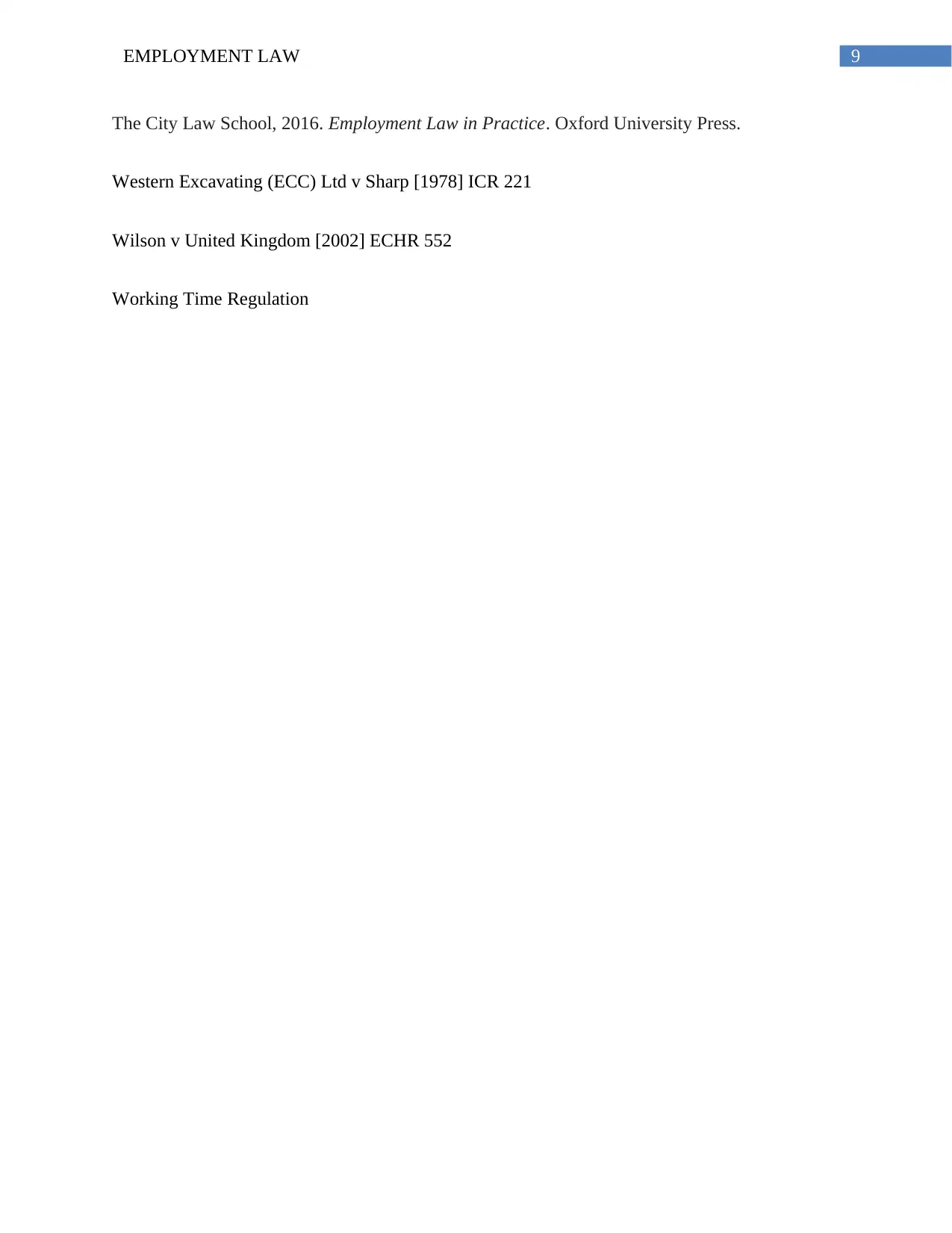
9EMPLOYMENT LAW
The City Law School, 2016. Employment Law in Practice. Oxford University Press.
Western Excavating (ECC) Ltd v Sharp [1978] ICR 221
Wilson v United Kingdom [2002] ECHR 552
Working Time Regulation
The City Law School, 2016. Employment Law in Practice. Oxford University Press.
Western Excavating (ECC) Ltd v Sharp [1978] ICR 221
Wilson v United Kingdom [2002] ECHR 552
Working Time Regulation
1 out of 10
Related Documents
Your All-in-One AI-Powered Toolkit for Academic Success.
+13062052269
info@desklib.com
Available 24*7 on WhatsApp / Email
![[object Object]](/_next/static/media/star-bottom.7253800d.svg)
Unlock your academic potential
Copyright © 2020–2025 A2Z Services. All Rights Reserved. Developed and managed by ZUCOL.



